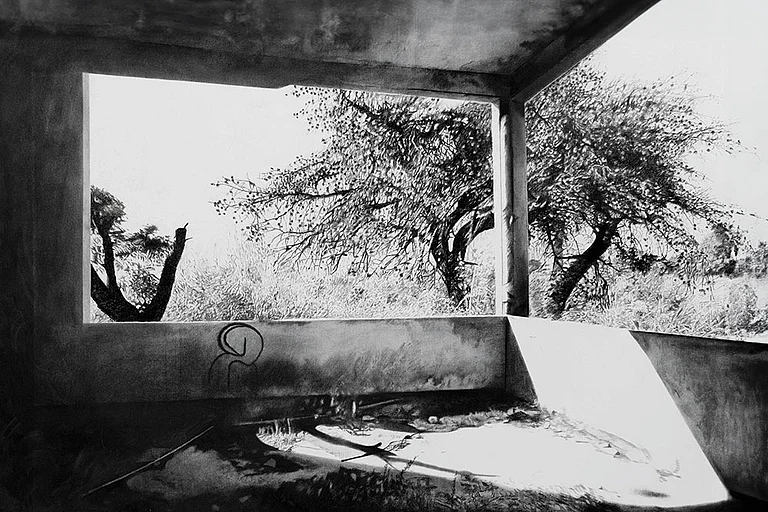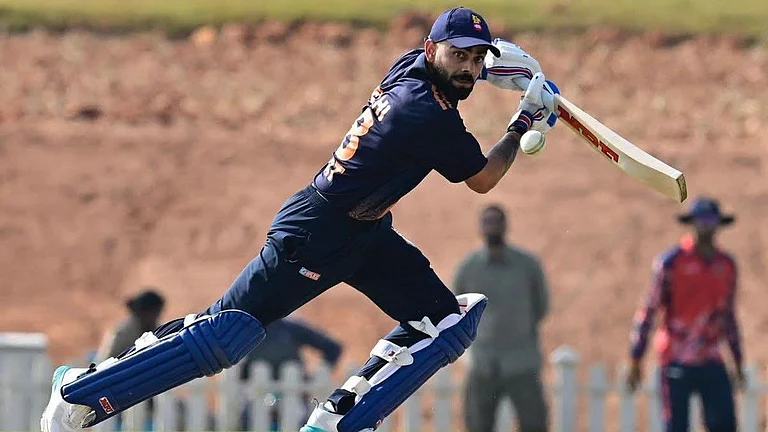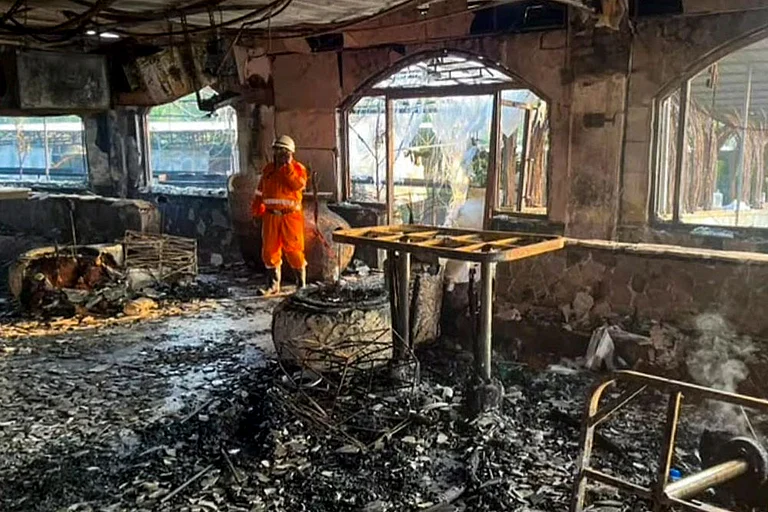Call it just an odd vibe, or an intimation of the unusual. It’s just before noon, and devotees are just trickling in at the Nirgun Paduka, but there’s something in the air of this 500-year-old temple at Ganagapur, north Karnataka, that puts you on guard. As the crowd settles down in the enclosure in front of the sanctum sanctorum, waiting for the prayers to begin, some look restless, deep in thought. As the drums pick up the rhythm, the signs of agitation are unmistakable.
Soon enough, there’s a damburst of emotions that could put the uninitiated in serious shock. Some of the women show the tell-tale signs of being ‘possessed’. They are laughing and crying, running helter-skelter as family members try to restrain them. Some try to climb the metal bracket in front of the enclosure (apparently installed for this reason alone). An old man too sways to the prayers. As the hour-long prayers come to an end, many of them drop on the floor, exhausted. Curious devotees, children among them, watch agog. The stray dogs look around rather disinterestedly. This seems to be a routine day for them. (In fact, they have the run of the place—the dog is the favourite animal of Dattatreya.) For, the temple in their lord’s name is famous in these parts for ‘curing’ mental illnesses.
Some two hours from Gulbarga, the road to Ganagapur kshetra is a very bumpy ride, almost a forewarning of what awaits us. Located on the banks of the confluence of two rivers and spread over a few kilometres, Ganagapur is a far less sophisticated enterprise compared to other temple towns like Pandharpur, Ganpatipule or Shirdi.
A family from Pandharpur have been here for some days now. “My bhabhi has been affected,” says one of its members. They are unwilling to be identified. The family circles over her, asks her questions about the “atma”, watch her collapse every now and then. Long after the prayers are over, families wait for the affected to wake up. (If they wake up with a heavy head, it could mean two things, a temple official explains helpfully—that they need to do more ‘seva’ or that they may just have been cured.)
Ganagapur kshetra is said to have acquired ‘cosmic energy’ after Narasimha Saraswati (1378-1458), the second incarnation of Lord Dattatreya, settled here. Spread over a few kilometres, it has several places of significance for the pious, like the sangam where the two rivers Bheema and Amarja join up (and the long-lost Saraswati, as the lore goes), the Audumbar tree, the Bhasmacha Dongar (mountain of ash), and the Nirgun Paduka and Kalleshwar temples. Now each of these is said to have its own special powers. Devotees come from far and wide believing in the healing powers of the place for illnesses like mental disorders, leprosy, orthopaedic maladies and so on.
The families, especially those of the female patients, are naturally reluctant to talk to outsiders. Vithhal Walunj, 58, whose son is ailing, is one of the few who’s forthcoming. He’s been here for the past 3-4 years. “My son has been affected, and so was I, but I have been doing seva now,” says Walunj, a Mumbai resident who’s “left everything behind” in a bid to get his 29-year-old son ‘cured’. “I know it’s hard for you to believe but there’s no other way out for us. We went to many doctors but all they asked us to do was more CT scans...they wasted our money. Now we are here and slowly things will get better,” he says, divulging that his daughter-in-law left with his grandchild after the ‘episodes’. The son remains tied up in the one-room house they live in and barely speaks.
He is not the first to surrender to Dattatreya here. “The cosmic energy here has been accepted even by doctors,” says Prasanna Nageshi, one of the main pujaris who performs the first puja in the pre-dawn hush at 3 am. He says they get a crowd of some 10,000 devotees daily, which goes up to some 70,000 on important days like the Datta Jayanti or other full moon days.
The temple pujaris not only arrange accommodation but also guide them on how to complete the rituals. The pujaris come from a single sub-community of Brahmins and have been doing these rituals for generations now. Just a few kilometres away are the ‘clinics’ (for want of a better word) where medicines are given mixed in sheep’s milk for arthritis pains. They are given almost free of cost—naturally, these too have their own pilgrim throngs. Believers say the legions who visit the Audumbar tree and the continuous chanting there has led to the “positive energy” it is said to radiate. Audumbar, a giant fig tree on the sangam banks, has a legend attached to it too—about how a leper was cured after Dattaguru helped him, and how the dry stick that he planted became this tree with healing powers. Around the tree, people sit reading religious texts. Devotees usually do ‘readings’ for anything from one to 21 days; in some cases, a longer stint is recommended. They have to be meditating, eating one meal a day and praying throughout. Audumbar also seems to function as a wish-tree of sorts, with thread sellers making a killing with new visitors and tourists. But this seems more a recent phenomenon, adding some colour to the environment.
Now with the levels of superstition and quackery prevalent in India, it’s not surprising that faith healing has its fair share of critics. And that is as it should be. But there’s also a view—and even psychiatrists and some rationalists agree here—that a regime of detox, rest and meditation could provide succour in some cases. Faith, of course, has a major part to play here. “Scientific evidence suggests that softer issues could get resolved with absolute faith. Unfortunately, this seems to lead people to believe in religious practices even more,” says psychiatrist Dr Harish Shetty, who’s treated several patients affected by ‘spirits’. “I would never blame the victim or his family as he/she is in need of urgent help. In the situation, it’s natural to turn to anything that promises a resolution.”

Photograph by Amit Haralkar
There’s another complex sociocultural context that rationalists and anti-superstition activists often cite. “With regard to the women patients, look at the lives they lead. Often they are poor, abused at home, with no voice, no economic independence. They get blamed for everything, from insufficient dowry to not producing sons. Sometimes the ‘illness’ is actually a temporary relief in their distressed lives,” says Nanal, an activist with the late Dr Narendra Dabholkar’s Andhashraddha Nirmoolan Samiti.
Indeed, helplessness drives people to do and accept things that are often beyond logic. At the Bhasmacha Dongar, the sadhus warn you to take off your slippers before you step on the ash mountain. An old mother is diligently putting ash on her adult son, as he sits quietly gazing at nothing. A father carries his differently abled child in his arms while the mother distributes alms. As they sit at the sanctum sanctorum in the main temple, their devotion feels absolute. “We expect nothing. We just want to be in god’s company,” says the father.
There are many devotees who come here expecting nothing, who treat this as an annual pilgrimage. At the sangam, S.R. Chintawar and his nine-member family are taking turns taking the holy dip. Every year, the entire family travels from Nanded—his daughters, married off in Mumbai and Solapur join them—to visit Ganagapur and Tuljapur. “I have completed all my duties as a husband, father and grandfather. I just wish to pray, enjoy the peace and solitude with my family. As long as I can move, I will keep coming,” says octogenarian Chintawar as his wife, daughters and their husbands nod cheerfully. “We don’t think of anything negative, we don’t tie threads or buy thalis. We just have a dip in the water and pray. These places give you peace,” he adds.
A much younger Aruna Artham has come all the way from Hyderabad. Originally from Gulbarga, she used to visit the temple regularly as a child. A practice she has continued even after her marriage. At the temple with her mother and toddler daughter, she watches the possessed women calmly and continues her prayers. “I have seen people get better. I have seen people come again and again for help or in gratitude. Whatever it is, if it helps, then why not?” she asks.


























